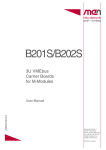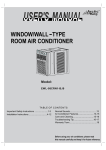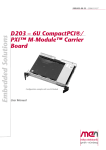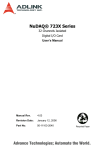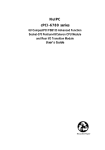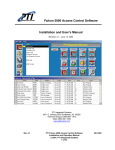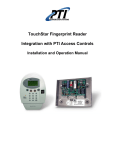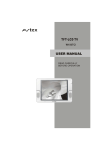Download D202 User Manual E2
Transcript
D202 6U CompactPCI® Carrier Board for PC•MIPs 20D202-00 E2 User Manual 1HXZLHGHU6WUDH '1UQEHUJ 3KRQH )D[ (0DLOLQIR#PHQGH :::ZZZPHQGH ,62FHUWLILHG D202 - 6U CompactPCI® Carrier Board for PC•MIP™ D202 - 6U CompactPCI® Carrier Board for PC•MIP™ PC•MIP Type I/Type II Support The D202 is a 6U CompactPCI carrier board for up to six PC•MIP modules. It supports four Type-I/II PC•MIPs and two Type-I PC•MIPs (without front-panel connector). Even if equipped with six PC•MIPs, the carrier needs only one slot on the CompactPCI bus. Mapping of I/O Signals to CompactPCI All PC•MIP I/Os on J3 of a PC•MIP are mapped to CompactPCI connectors J3, J4 or J5. The mapping is standardized. Installation The PC•MIPs are tightly installed on the carrier board through an injector/ejector mechanism with two captive screws on the carrier. While self-aligning the connectors when being tightened, the screws will push the PC•MIP out of the connectors when loosened. Fast and Flexible PC•MIPs are an ideal solution for flexible and fast CPU-related applications, which can make advantage out of the internal PCI bus of the PC•MIPs. Technical Data CompactPCI Bus: • compliance with CompactPCI Specification 2.0 R2.1 • only one slot required on the 6U CompactPCI bus • DECchip 21150 PCI-to-PCI bridge - target and/or initiator on PCI bus - max. clock frequency 33MHz - power supply 5V and 3.3V • compliance with PCI Specification 2.1 • 32-bit PCI data bus PC•MIPs: • up to six PC•MIP modules on one board • support of 2 Type I and 4 Type II modules • local 32-bit PCI bus MEN Mikro Elektronik GmbH 20D202-00 E2 2 Technical Data Peripheral Connections: • via front panel • via CompactPCI J3/J4/J5 Electrical Specifications: • supply voltage/power consumption: - +5V (4.85V..5.25V) @ 5mA typ. - +3.3V @ 150mA typ. • MTBF: 80,000h @ 50°C Mechanical Specifications: • dimensions: conforming to CompactPCI specification for 6U boards • front panel: aluminum with 2 handles • weight: 320g Environmental Specifications: • temperature range (operation): 0..+60°C (industrial temperature range on request) • temperature range (storage): -40..+85°C • relative humidity range (operation): max. 95% non-condensing • relative humidity range (storage): max. 95% non-condensing • altitude: -300m to + 3,000m • shock: 15g/0.33ms, 6g/6ms • vibration: 1g/5..2,000Hz Safety: • PCB manufactured with a flammability rating of 94V-0 by UL recognized manufacturers EMC: • tested according to IEC1000-4-2 (burst) and IEC1000-4-4 (ESD) with regard to CE conformity Software Support: • PC•MIP driver software for WindowsNT®, VxWorks® and OS-9® MEN Mikro Elektronik GmbH 20D202-00 E2 3 Block Diagram Block Diagram CompactPCI Bus PCI-to-PCI Bridge PC•MIP Type II Local PCI Bus PC•MIP Type II PC•MIP Type I PC•MIP Type I PC•MIP Type II Rear I/O via CompactPCI J3/J4/J5 Connectors Front I/O via Front-Panel Connectors PC•MIP Type II Ordering Information Standard Hardware 02D202-00 D202 PC•MIP carrier board Rear I/O Adapter 08CT01-00 CT01, 6U CompactPCI transition module 6U/80mm, six 50-pin and four 68-pin ribbon-cable connectors User Manuals 20D202-00 D202 user manual 20CT01-00 MEN Mikro Elektronik GmbH 20D202-00 E2 CT01 user manual 4 About the Manual About the Manual This user manual describes the hardware functions of the carrier board, connection of peripheral devices and integration into a system. It also provides additional information for special applications and configurations of the board. The manual does not include detailed information on individual components (data sheets etc.). A list of literature is given in the appendix. History Edition Description Technical Content Date of Issue E1 First edition Peter Marek August 24, 1998 E2 Second edition Jonny Speckner December 16, 1999 Conventions ! italics bold hyperlink This sign marks important notes or warnings concerning proper functionality of the product described in this manual. You should read them in any case. Folder and file names are printed in italics. Bold type is used for emphasis. Hyperlinks are printed in blue color. 0xFF Hexadecimal numbers are preceded by "0x", which is the usual C-language convention, and are printed in a monospace type, e.g. 0x00FFFF. IRQ# Signal names followed by "#" indicate that this signal is either active low or that it becomes active at a falling edge. in/out Signal directions in signal mnemonics tables generally refer to the corresponding board or component, "in" meaning "to the board or component", "out" meaning "coming from it". Vertical lines on the outer margin signal technical changes to the previous edition of the manual. MEN Mikro Elektronik GmbH 20D202-00 E2 5 About the Manual Short Glossary of PC•MIP Terms For a complete glossary of PC•MIP terms and definitions, please refer to the PC•MIP specification. Connector-side The surface of the PC•MIP module that faces the carrier board when installed. This face is opposite the label-side. J1, J2 J1 and J2 are two 64-pin receptacle connectors on the PC•MIP module that carry the 32-bit PCI bus via which the carrier and the module communicate. J1 and J2 mate to P1 and P2 on the carrier board respectively. J3 J3 is the 64-pin I/O receptacle connector between the module and the carrier board. 14 ground pins are defined on this connector by the specification, but the remaining 50 pin functions are defined by each module. J3 mates to P3 on the carrier board. J4 J4 is a term reserved for the "front panel" I/O connector on type II PC•MIP modules, but not on type I modules. The selection of the physical connector is left to manufacturer of the type II module, and is not defined in the specification. J4 typically mates to a an equivalent P4 connector on a cable. Label-side The surface of the PC•MIP module that is visible when the module is installed on a carrier board. This face is opposite the connector-side. MEN reserves the right to make changes without further notice to any products herein. MEN makes no warranty, representation or guarantee regarding the suitability of its products for any particular purpose, nor does MEN assume any liability arising out of the application or use of any product or circuit, and specifically disclaims any and all liability, including without limitation consequential or incidental damages. "Typical" parameters can and do vary in different applications. All operating parameters, including "Typicals" must be validated for each customer application by customer's technical experts. MEN does not convey any license under its patent rights nor the rights of others. MEN products are not designed, intended, or authorized for use as components in systems intended for surgical implant into the body, or other applications intended to support or sustain life, or for any other application in which the failure of the MEN product could create a situation where personal injury or death may occur. Should Buyer purchase or use MEN products for any such unintended or unauthorized application, Buyer shall indemnify and hold MEN and its officers, employees, subsidiaries, affiliates, and distributors harmless against all claims, costs, damages, and expenses, and reasonable attorney fees arising out of, directly or indirectly, any claim of personal injury or death associated with such unintended or unauthorized use, even if such claim alleges that MEN was negligent regarding the design or manufacture of the part. All brand or product names are trademarks or registered trademarks of their respective holders. Information in this document has been carefully checked and is believed to be accurate as of the date of publication; however, no responsibility is assumed for inaccuracies. MEN will not be liable for any consequential or incidental damages arising from reliance on the accuracy of this document. The information contained herein is subject to change without notice. Copyright © 1999 MEN Mikro Elektronik GmbH. All rights reserved. MEN Mikro Elektronik GmbH 20D202-00 E2 6 Contents Contents 1 Getting Started . . . . . . . . . . . . . . . . . . . . . . . . . . . . . . . . . . . . . . . . . . . . . . . . . 8 1.1 Map of the Board. . . . . . . . . . . . . . . . . . . . . . . . . . . . . . . . . . . . . . . . . . 8 1.2 Installation Check List. . . . . . . . . . . . . . . . . . . . . . . . . . . . . . . . . . . . . . 9 1.3 Installing PC•MIPs . . . . . . . . . . . . . . . . . . . . . . . . . . . . . . . . . . . . . . . 10 1.4 Installing Driver Software . . . . . . . . . . . . . . . . . . . . . . . . . . . . . . . . . . 10 2 Functional Description . . . . . . . . . . . . . . . . . . . . . . . . . . . . . . . . . . . . . . . . . . 2.1 Power Supply. . . . . . . . . . . . . . . . . . . . . . . . . . . . . . . . . . . . . . . . . . . . 2.2 CompactPCI Interface . . . . . . . . . . . . . . . . . . . . . . . . . . . . . . . . . . . . . 2.3 PC•MIP Connectors. . . . . . . . . . . . . . . . . . . . . . . . . . . . . . . . . . . . . . . 2.4 PC•MIP Rear I/O Mapping . . . . . . . . . . . . . . . . . . . . . . . . . . . . . . . . . 11 11 11 11 12 3 Organization of the Board . . . . . . . . . . . . . . . . . . . . . . . . . . . . . . . . . . . . . . . 15 4 Appendix . . . . . . . . . . . . . . . . . . . . . . . . . . . . . . . . . . . . . . . . . . . . . . . . . . . . . 4.1 Literature . . . . . . . . . . . . . . . . . . . . . . . . . . . . . . . . . . . . . . . . . . . . . . . 4.2 Board Revisions. . . . . . . . . . . . . . . . . . . . . . . . . . . . . . . . . . . . . . . . . . 4.3 Configuration Plan. . . . . . . . . . . . . . . . . . . . . . . . . . . . . . . . . . . . . . . . 16 16 16 17 Figures Figure 1: Map of the Board - Top View . . . . . . . . . . . . . . . . . . . . . . . . . . . . . . . . 8 Figure 2: Installation of a PC•MIP. . . . . . . . . . . . . . . . . . . . . . . . . . . . . . . . . . . . 10 Figure 3: Configuration Plan of D202 Rev. 01 . . . . . . . . . . . . . . . . . . . . . . . . . . 17 Tables Table 1: Table 2: Table 3: Table 4: Table 5: Table 6: Table 7: MEN Mikro Elektronik GmbH 20D202-00 E2 PC•MIP Rear I/O Mapping . . . . . . . . . . . . . . . . . . . . . . . . . . . . . . . . . Pin Assignment of CompactPCI J3 (95-pin type "B" modified) . . . . . Pin Assignment of CompactPCI J4 (110-pin type "A") . . . . . . . . . . . . Pin Assignment of CompactPCI J5 (110-pin type "B" modified) . . . . Signal Mnemonics for CompactPCI J3, J4 and J5 . . . . . . . . . . . . . . . . Device Numbers on Local PCI Bus . . . . . . . . . . . . . . . . . . . . . . . . . . . Table of Hardware Revisions . . . . . . . . . . . . . . . . . . . . . . . . . . . . . . . . 12 12 13 14 14 15 16 7 Getting Started 1 Getting Started This chapter will give an overview of the carrier board and some hints for first installation in a system as a "check list". 1.1 Map of the Board Figure 1: Map of the Board - Top View P2 J5 PC•MIP Slot A P1 P2 Bezel Keepers P1 P3 PC•MIP Slot E P3 P3 P2 PC•MIP Slot B J4 P1 P3 P2 J3 PC•MIP Slot C P1 P2 P1 Finished Bezel of I/O Connector P3 PC•MIP Slot F P3 P2 J2 PC•MIP Slot D P1 J1 Keeper Screw (solder side) MEN Mikro Elektronik GmbH 20D202-00 E2 Injectors/Ejectors with Threaded Standoffs and Captive Screws 8 Getting Started 1.2 Installation Check List You can use the following "check list" when installing the D202 in a CompactPCI system for the first time. ! Note: The D202 must not be inserted into the system slot! The system slot of every CompactPCI system is marked by a triangle on the backplane and/or at the front panel. It also has red guide rails. ; Power-down the system. ; Install a PC•MIP as described below. ; Insert the D202 into your CompactPCI system, making sure that the CompactPCI connectors are properly aligned. ; Power-up the system. ; You can now install driver software for the PC•MIPs on the carrier board. MEN Mikro Elektronik GmbH 20D202-00 E2 9 Getting Started 1.3 ! Installing PC•MIPs Note: It is possible to plug Type-I modules on Type-II slots. However, you cannot do this vice versa, since the front connectors of Type-II modules would collide with neighboring modules or with the enclosure. Perform the following steps to install a PC•MIP: ; Power down your system and remove the D202 from the system. ; If you want to install a Type-II PC•MIP (with front connector), you must remove the blank bezel at the front panel of the D202 first: Remove the respective bezel keeper by loosening the keeper screw at the solder side of the D202. (See Figure 1, Map of the Board - Top View, on page 8). ; Place the finished bezel supplied with your PC•MIP in the front panel cut-out and reinstall the bezel keeper. ; If you are installing a Type-II PC•MIP, carefully put the module’s front connector through the finished bezel, holding the module at a 45° angle. ; Place the PC•MIP on the target slot of the D202, aligning the two connectors (P1/J1, P2/J2) and the two standoffs. ; Screw the PC•MIP to the carrier by alternately tightening the two captive screws on the label side of the PC•MIP. The module will be "injected" safely. Figure 2: Installation of a PC•MIP System Front Panel Captive Screw J3 P3 PC•MIP Front I/O Connector (Type II module) PC•MIP (Type I or II) Standoff J1 P1 Captive Screw Standoff Carrier Board Keeper Keeper Screw To deinstall PC•MIPs from the carrier board, just loosen the appropriate screws at the label side of the PC•MIP. The injector/ejector system will "eject" the PC•MIP. 1.4 Installing Driver Software For a detailed description on how to install driver software please refer to the respective PC•MIP software manual or MEN’s general online MDIS documentation "MDIS 4 - MEN Driver Interface System, The Complete User Guide". The MDIS guide is named 21m00007.pdf and is provided with any of MEN’s operating-system specific MDIS software packages. MEN Mikro Elektronik GmbH 20D202-00 E2 10 Functional Description 2 Functional Description 2.1 Power Supply Power supply is fed via the CompactPCI backplane. The board operates on +5V and 3.3V, i.e. you must supply +3.3V. You need to supply +12V/-12V only if required by one of the PC•MIPs installed. Power consumption is 400mA max. plus the current drawn by PC•MIPs stacked on the carrier board. 2.2 CompactPCI Interface The D202 carrier board has a 32-bit CompactPCI interface on connectors J1/J2. It supports universal signaling voltage on CompactPCI. For a pinout of the 32-bit CompactPCI interface on J1/J2 and a general description of ComapctPCI, please refer to the CompactPCI specification. Connector types of J1/J2: • 110-pin shielded, 2mm-pitch, 5-row receptacle according to IEC 917 and IEC 1076-4-101 The interface is implemented using a DEC DS21150 PCI target interface from Intel. This device complies with the PCI Specification Rev. 2.1 and is able to perform zero wait state transfers over the CompactPCI bus. 2.3 PC•MIP Connectors PC•MIP modules connect to the D202’s PCI bus via the two identical 64-pin connectors P1 and P2. The connector layout is fully compatible to the PC•MIP specification and will not be repeated here. The I/O connection with the carrier is via a third, identical 64-pin connector: P3. The signals of this connector are mapped to CompactPCI connectors J3, J4 and J5 (see Chapter 2.4 PC•MIP Rear I/O Mapping on page 12). Connector types of P1, P2 and P3: • 64-pin plug connector according to IEEE P1386, e.g. Molex 71436-0164 • mating connector: 64-pin receptacle connector according to IEEE P1386, e.g. Molex 71439-0164 MEN Mikro Elektronik GmbH 20D202-00 E2 11 Functional Description 2.4 PC•MIP Rear I/O Mapping The I/O signals of all six PC•MIP slots are mapped to CompactPCI connectors J3, J4 and J5. Connector types of J3/J4/J5: • 95-pin/110-pin shielded, 2mm-pitch, 5-row receptacle according to IEC 917 and IEC 1076-4-101 Table 1: PC•MIP Rear I/O Mapping PC•MIP Slot ! A J5, rows 11..1 B J4, rows 25..15 C J3, rows 19..9 D J3, rows 8..1 E J5, rows 22..12 F J4, rows 11..1 Note: The I/O lines of slot D cannot be fully mapped due to a lack of pins on the CompactPCI connectors. Consequently, this socket should be preferred for use with PC•MIPs using front panel I/O or no I/O at all. Table 2: Pin Assignment of CompactPCI J3 (95-pin type "B" modified) A B C D E F 19 18 1 MEN Mikro Elektronik GmbH 20D202-00 E2 CompactPCI A B C D E F 19 C50 C49 C48 C47 C46 GND 18 C45 C44 C43 C42 C41 GND 17 C40 C39 C38 C37 C36 GND 16 C35 C34 C33 C32 C31 GND 15 C30 C29 C28 C27 C26 GND 14 C25 C24 C23 C22 C21 GND 13 C20 C19 C18 C17 C16 GND 12 C15 C14 C13 C12 C11 GND 11 C10 C9 C8 C7 C6 GND 10 C5 C4 C3 C2 C1 GND 9 +3.3V +3.3V +3.3V +5V +5V GND 8 D35 D34 D33 D32 D31 GND 7 D30 D29 D28 D27 D26 GND 6 D25 D24 D23 D22 D21 GND 5 D20 D19 D18 D17 D16 GND 4 D15 D14 D13 D12 D11 GND 3 D10 D9 D8 D7 D6 GND 2 D5 D4 D3 D2 D1 GND 1 +3.3V +3.3V +3.3V +5V +5V GND 12 Functional Description Table 3: Pin Assignment of CompactPCI J4 (110-pin type "A") A B C D E F 25 24 A B C D E F 25 B50 B49 B48 B47 B46 GND 24 B45 B44 B43 B42 B41 GND 23 B40 B39 B38 B37 B36 GND 22 B35 B34 B33 B32 B31 GND 21 B30 B29 B28 B27 B26 GND 20 B25 B24 B23 B22 B21 GND 19 B20 B19 B18 B17 B16 GND 18 B15 B14 B13 B12 B11 GND 17 B10 B9 B8 B7 B6 GND 16 B5 B4 B3 B2 B1 GND 15 +3.3V +3.3V +3.3V +5V +5V GND Voltage Key Voltage Key 1 MEN Mikro Elektronik GmbH 20D202-00 E2 11 F50 F49 F48 F47 F46 GND 10 F45 F44 F43 F42 F41 GND 9 F40 F39 F38 F37 F36 GND 8 F35 F34 F33 F32 F31 GND 7 F30 F29 F28 F27 F26 GND 6 F25 F24 F23 F22 F21 GND 5 F20 F19 F18 F17 F16 GND 4 F15 F14 F13 F12 F11 GND 3 F10 F9 F8 F7 F6 GND 2 F5 F4 F3 F2 F1 GND 1 +3.3V +3.3V +3.3V +5V +5V GND 13 Functional Description Table 4: Pin Assignment of CompactPCI J5 (110-pin type "B" modified) A B C D E F 22 21 1 Table 5: B C D E F 22 E50 E49 E48 E47 E46 GND 21 E45 E44 E43 E42 E41 GND 20 E40 E39 E38 E37 E36 GND 19 E35 E34 E33 E32 E31 GND 18 E30 E29 E28 E27 E26 GND 17 E25 E24 E23 E22 E21 GND 16 E20 E19 E18 E17 E16 GND 15 E15 E14 E13 E12 E11 GND 14 E10 E9 E8 E7 E6 GND 13 E5 E4 E3 E2 E1 GND 12 +3.3V +3.3V +3.3V +5V +5V GND 11 A50 A49 A48 A47 A46 GND 10 A45 A44 A43 A42 A41 GND 9 A40 A39 A38 A37 A36 GND 8 A35 A34 A33 A32 A31 GND 7 A30 A29 A28 A27 A26 GND 6 A25 A24 A23 A22 A21 GND 5 A20 A19 A18 A17 A16 GND 4 A15 A14 A13 A12 A11 GND 3 A10 A9 A8 A7 A6 GND 2 A5 A4 A3 A2 A1 GND 1 +3.3V +3.3V +3.3V +5V +5V GND Signal Mnemonics for CompactPCI J3, J4 and J5 Signal Direction Function +3.3V - +3.3V power supply +5V - +5V power supply GND - logic ground C[50:1] in/out PC•MIP C rear panel I/Os [50:1] D[35:1] in/out PC•MIP D rear panel I/Os [35:1] B[50:1] in/out PC•MIP B rear panel I/Os [50:1] F[50:1] in/out PC•MIP F rear panel I/Os [50:1] E[50:1] in/out PC•MIP E rear panel I/Os [50:1] A[50:1] in/out PC•MIP A rear panel I/Os [50:1] MEN Mikro Elektronik GmbH 20D202-00 E2 A 14 Organization of the Board 3 Organization of the Board Table 6: Device Numbers on Local PCI Bus Device Number ! 0x0A F 0x0B E 0x0C A 0x0D B 0x0E C 0x0F D Note: With some CPU boards that have PCI-to-PCI bridges there may be problems if there are several D202 boards in the system. This is due to the BIOS on the CPU board and not the D202! Please contact the respective CPU manufacturer for a BIOS update. There are no problems with MEN’s CPU boards! MEN Mikro Elektronik GmbH 20D202-00 E2 PC•MIP Slot 15 Appendix 4 Appendix 4.1 Literature • PC•MIP Draft Standard: draft standard ANSI/VITA 29; VMEbus International Trade Association 7825 E. Gelding Dr., Ste. 104, Scottsdale, AZ 85260 WWW: http://www.vita.com You can download the latest draft specification also from MEN’s web site: http://www.men.de. 4.2 Board Revisions Table 7: Table of Hardware Revisions Revision Restrictions 00.xx first revision none known 01.xx second revision none known MEN Mikro Elektronik GmbH 20D202-00 E2 Comment 16 Appendix 4.3 Configuration Plan Figure 3: Configuration Plan of D202 Rev. 01 MEN Mikro Elektronik GmbH 20D202-00 E2 17 You can request the circuit diagrams for the current revision of the product described in this manual by completely filling out and signing the following non-disclosure agreement. Please send the agreement to MEN by mail. We will send you the circuit diagrams along with a copy of the completely signed agreement by return mail. MEN reserves the right to refuse sending of confidential information for any reason that MEN may consider substantial. Non-Disclosure Agreement for Circuit Diagrams provided by MEN Mikro Elektronik GmbH between MEN Mikro Elektronik GmbH Wiesentalstr. 40 D-90419 Nürnberg (”MEN”) and ____________________ ____________________ ____________________ ____________________ (”Recipient”) We confirm the following Agreement: MEN Recipient Date: ______________________ Date: ______________________ Name: ______________________ Name: ______________________ Function: ______________________ Function: ______________________ Signature: Signature: ____________________________________ ____________________________________ The following Agreement is valid as of the date of MEN’s signature. 1HXZLHGHU6WUDH '1UQEHUJ 3KRQH )D[ (0DLOLQIR#PHQGH :::ZZZPHQGH Non-Disclosure Agreement for Circuit Diagrams page 1 of 2 ,62FHUWLILHG 1 Subject The subject of this Agreement is to protect all information contained in the circuit diagrams of the following product: Article Number:__________________ [filled out by recipient] MEN provides the recipient with the circuit diagrams requested through this Agreement only for information. 2 Responsibilities of MEN Information in the circuit diagrams has been carefully checked and is believed to be accurate as of the date of release; however, no responsibility is assumed for inaccuracies. MEN will not be liable for any consequential or incidental damages arising from reliance on the accuracy of the circuit diagrams. The information contained therein is subject to change without notice. 3 Responsibilities of Recipient The recipient, obtaining confidential information from MEN because of this Agreement, is obliged to protect this information. The recipient will not pass on the circuit diagrams or parts thereof to third parties, neither to individuals nor to companies or other organizations, without the written permission by MEN. The circuit diagrams may only be passed to employees who need to know their content. The recipient protects the confidential information obtained through the circuit diagrams in the same way as he protects his own confidential information of the same kind. 4 Violation of Agreement The recipient is liable for any damage arising from violation of one or several sections of this Agreement. MEN has a right to claim damages amounting to the damage caused, at least to DM 100,000. 5 Other Agreements MEN reserves the right to pass on its circuit diagrams to other business relations to the extent permitted by the Agreement. Neither MEN nor the recipient acquire licenses for the right of intellectual possession of the other party because of this Agreement. This Agreement does not result in any obligation of the parties to purchase services or products from the other party. 6 Validity of Agreement The period after which MEN agrees not to assert claims against the recipient with respect to the confidential information disclosed under this Agreement shall be _______ months [filled out by MEN]. (Not less than twenty-four (24) nor more than sixty (60) months.) 7 General If any provision of this Agreement is held to be invalid, such decision shall not affect the validity of the remaining provisions and such provision shall be reformed to and only to the extent necessary to make it effective and legal. This Agreement is only effective if signed by both parties. Amendments to this Agreement can be adopted only in writing. There are no supplementary oral agreements. This Agreement shall be governed by German Law. The court of jurisdiction shall be Nuremberg. 1HXZLHGHU6WUDH '1UQEHUJ 3KRQH )D[ (0DLOLQIR#PHQGH :::ZZZPHQGH Non-Disclosure Agreement for Circuit Diagrams page 2 of 2 ,62FHUWLILHG Fax Reply Who you are... Name __________________________ Phone No. __________________________ Company __________________________ Fax No. __________________________ Department __________________________ E-mail __________________________ Use our online forms at http://www.men.de What we can do for you... Product Support Manual Feedback Product Article No. __________________ Manual Article No. __________________ Revision __ __ . __ __ . __ __ Edition If the product is a mezzanine module: Carrier Article No. __________________ Revision __ __ . __ __ . __ __ E ___ Useful or awful? very useful totally awful Operating system Usage OS-9 I read the manual and decided to buy the VxWorks WindowsNT other: ___________________________________ • Technical Support • User Manuals related product. I read the manual when I got the product. I referred to the manual only when I had installation problems. Your problems/comments... 1HXZLHGHU6WUDH '1UQEHUJ 3KRQH )D[ (0DLOLQIR#PHQGH :::ZZZPHQGH ,62FHUWLILHG





















